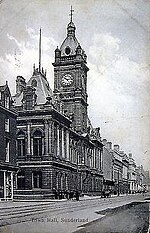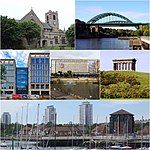Vaux Site
Buildings and structures in the City of SunderlandBuildings and structures under construction in the United KingdomCity of SunderlandNorth East EnglandProposed buildings and structures in England
The Vaux Site is an area of brownfield land in the centre of Sunderland, Tyne and Wear currently undergoing development. The area of the former Vaux Breweries until its closure in 1999, the council are recreating the site in a multi-million pound joint venture with Carillion. The development will create up to 19 new buildings for leisure, retail, living and office purposes. Phase one of construction started in 2016 with work on a series of offices valued at £25 million
Excerpt from the Wikipedia article Vaux Site (License: CC BY-SA 3.0, Authors).Vaux Site
St. Mary's Boulevard, Sunderland Ashbrooke
Geographical coordinates (GPS) Address Nearby Places Show on map
Geographical coordinates (GPS)
| Latitude | Longitude |
|---|---|
| N 54.907878 ° | E -1.38617 ° |
Address
St. Mary's Boulevard
St. Mary's Boulevard
SR1 3AA Sunderland, Ashbrooke
England, United Kingdom
Open on Google Maps









